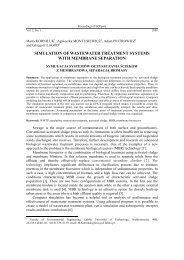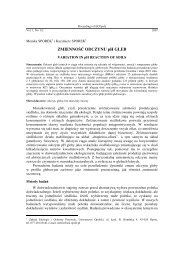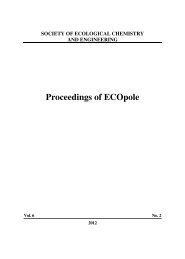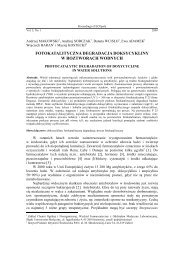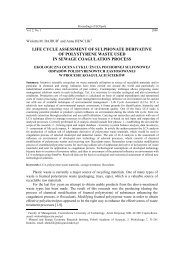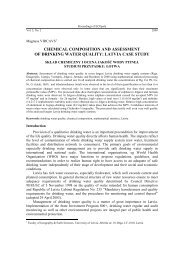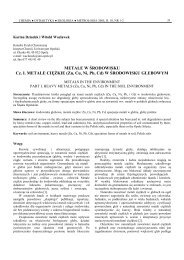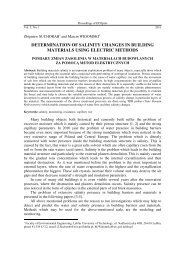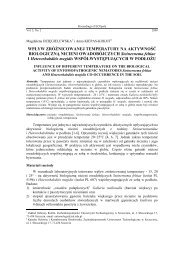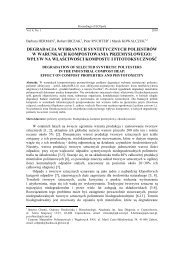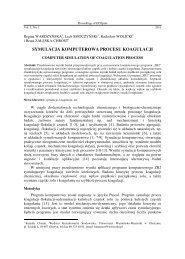HEAVY METALS BIOSORPTION FROM AQUEOUS SOLUTION BY ...
HEAVY METALS BIOSORPTION FROM AQUEOUS SOLUTION BY ...
HEAVY METALS BIOSORPTION FROM AQUEOUS SOLUTION BY ...
You also want an ePaper? Increase the reach of your titles
YUMPU automatically turns print PDFs into web optimized ePapers that Google loves.
Proceedings of ECOpole<br />
Vol. 4, No. 1 2010<br />
Sławomir WIERZBA 1<br />
<strong>HEAVY</strong> <strong>METALS</strong> <strong>BIOSORPTION</strong> <strong>FROM</strong> <strong>AQUEOUS</strong> <strong>SOLUTION</strong><br />
<strong>BY</strong> Pseudomonas sp. G1<br />
BIOSORPCJA METALI CIĘŻKICH Z ROZTWORÓW WODNYCH<br />
PRZEZ Pseudomonas sp. G1<br />
Abstract: The objectives of the study are to compare the living and non-living cells of Pseudomonas sp. G1 in<br />
their removal capacity of Cu(II) and Zn(II). For these purposes, the removal capacity, desorption efficiency of<br />
living and non-living cells and various factors affecting the adsorption, such as reaction time, initial pH of the<br />
solution and metal concentration were determined. It was found that the optimum pH value for Cu(II) removal by<br />
living and nonliving cells was 5.0, while it was 6.0 and 5.0, respectively, for Zn(II) removal. The binding capacity<br />
by living cells is significantly higher than that of dead cells at tested conditions. Most of the metal adsorption<br />
occurred during the first 10 min. Moreover, desorption efficiency of Cu(II) and Zn(II) by living cells was 76.3 and<br />
68.4% under 0.1 M HCl and it was 93.1 and 86.5% by non-living cells, respectively.<br />
Keywords: biosorption, copper, zinc, Pseudomonas sp.<br />
The presence of heavy metals in wastewater can cause severe damage to aquatic life,<br />
killing microorganisms during biological treatment of wastewater with a consequent delay<br />
of the process of water purification. Most heavy metal salts are soluble in water and, as<br />
a consequence, cannot be separated by ordinary physical separation methods [1].<br />
Conventional methods for removing metals from aqueous solutions include: chemical<br />
precipitation, chemical oxidation or reduction, ion exchange, filtration, reverse osmosis,<br />
membrane technologies, and evaporation recovery. These processes may be ineffective or<br />
extremely expensive, especially when the metals in solution are in the range of<br />
1÷100 mg · dm –3 [1, 2]. Biosorption, based on living or nonliving microorganisms or plants,<br />
offers the reduction of toxic metal levels to environmentally acceptable limits in<br />
a cost-effective and environmentally friendly manner. The big advantages of biosorption are<br />
the low operating cost, minimization of the volume of chemical and/or biological sludge to<br />
be disposed of, and high efficiency in detoxifying very dilute effluents [3].<br />
The objectives of the study are to compare the living and non-living cells of<br />
Pseudomonas sp. G1 with their removal capacity of Cu(II) and Zn(II). For these purposes,<br />
the removal capacity, desorption efficiency of living and non-living cells and various<br />
factors affecting the adsorption, such as reaction time, initial pH value of the solution and<br />
metal concentration.<br />
Material and methods<br />
The microorganisms used in the study were isolated from wastewater treatment plant<br />
located in Glubczyce (Poland), and identified as Pseudomonas sp. G1. Biosorption<br />
experiments were conducted at 30°C in batch with 0.1 g of the living or non-living cells in<br />
a 250 cm 3 flask containing 50 cm 3 of working solution volume. Experiments for<br />
determining the kinetics of the process were performed at 100 mg · dm –3 initial metal<br />
1 Chair of Biotechnology and Molecular Biology, Opole University, ul. kard. B. Kominka 4, 40-035 Opole,<br />
tel. 77 401 60 55, email: slawomir.wierzba@uni.opole.pl
86<br />
Sławomir Wierzba<br />
concentrations for Cu(II) and Zn(II). Samples were taken at desired intervals and were<br />
subsequently centrifuged at 4000 rpm for 20 min. The impact of the solution pH on the<br />
metal biosorption was investigated in the same way except that the initial pH of the<br />
solutions was adjusted from 4 to 8 with the addition of either 0.1 M HNO3 or 0.1 M NaOH.<br />
Desorption of Cu(II) and Zn(II) from previously loaded living and non-living Pseudomonas<br />
sp. G1 was studied by using 0.1 M HCl as eluent. The concentrations of initial and final<br />
Cu(II) and Zn(II) in the biosorption experiments were determined spectrophotometrically in<br />
a spectrophotometer Photolab Spectral. The amount of metal adsorbed by bacterial biomass<br />
was calculated from the differences between the metal quantity added to the biomass and<br />
the metal content of the supernatant using the following equation (1):<br />
( C − C )<br />
0 e ⋅ V<br />
Q = (1)<br />
m<br />
where Q [mg · g –1 ] is the adsorption quantity at the equilibrium, C0 and Ce are the initial<br />
and equilibrium concentrations [mg · dm –3 ], V the volume of solution [dm 3 ], m the weight<br />
of biomass [g] in grams.<br />
Results and discussion<br />
The pH value is one of the most important parameters that influence the biochemical<br />
behaviors of metal ions in an aqueous system, as the pH value of the system directly affects<br />
the metal speciation in the solution, which can change the biosorption capability [3-5].<br />
Fig. 1. Effect of initial pH on biosorption capacity of (a) Cu(II) and (b) Zn(II) by living and non-living<br />
Pseudomonas sp. G1<br />
Figures 1a, b summarizes the results of the adsorption of Cu(II) and Zn(II) ions by<br />
biomass Pseudomonas sp. G1 as a function of pH. In all cases, metal biosorption by the<br />
biomass increases with increasing pH till it reaches a maximum after which the metal<br />
biosorption decreases. It was found that the optimum pH for Cu(II) removal by living and<br />
nonliving cells was 5.0, while it was 6.0 and 5.0, respectively, for Zn(II) removal. These<br />
results suggest that the adsorption of metals on the biomass surface is controlled by ionic
Heavy metals biosorption from aqueous solution by Pseudomonas sp. G1<br />
attraction. At low pH values, the inactivated cell surface becomes more positively charged,<br />
leading to reduce the attraction between metal ions and functional groups at the cell wall. In<br />
contrast, when the pH value increases, the cell surface is more negatively charged and the<br />
process of retention is favored until a maximum is reached around pH 5 or 6 [4-7].<br />
However, for values of pH higher than the optimum, the formation of hydroxylated<br />
complexes of the metal will also compete with the active sites and, as a consequence, the<br />
retention will decrease again [1].<br />
Fig. 2. Kinetic of (a) Cu(II) and (b) Zn(II) biosorption by living and non-living Pseudomonas sp. G1<br />
Figure 2 shows the effect of reaction time on the biosorption of Cu(II) and Zn(II) by<br />
Pseudomonas sp. G1 biomass from aqueous solutions. The rate of metal uptake increases<br />
rapidly in the first part within 10 min of contact. After that the rate decreases till we reach<br />
a constant value of metal concentration after 40 min. Therefore, one can conclude that the<br />
appropriate equilibrium time for measurements was taken at 40 min. This short time<br />
required for biosorption is in accordance with the result given by other authors [1, 3, 6, 8].<br />
The binding capacity by living cells is significantly higher that of dead cells at tested<br />
conditions. The maximum removal capacities of Cu(II) nad Zn(II) by biomass<br />
Pseudomonas sp. G1 were 28.9 and 25.2 mg · g –1 , respectively.<br />
Desorption of Cu(II) and Zn(II) from living and non-living Pseudomonas sp. G1<br />
Metals Biosorbent Sorption [mg · g –1 ] Desorption [mg · g –1 ] Desorption [%]<br />
Cu(II) Living 28.9 22.1 76.3<br />
Non-living 18.4 17.1 93.1<br />
Zn(II) Living 25.2 17.2 68.4<br />
Non-living 16.2 14.0 86.5<br />
87<br />
Table 1
88<br />
Sławomir Wierzba<br />
The experiment results of Cu(II) and Zn(II) biosorption and desorption are reported in<br />
Table 1. Desorption efficiency of Cu(II) and Zn(II) by living cells was 76.3 and 68.4%<br />
under 0.1 M HCl and it was 93.1 and 86.5% by non-living cells, respectively. It indicates<br />
that 0.1 M HCl can effectively desorbs the bound Cu(II) and Zn(II) from non-living cells,<br />
but not very effective for living cells. And the desorption of Cu(II) is more effective than<br />
that of Zn(II). It also may be due to the living cells uptake a part of Cu(II) and Zn(II)<br />
through intracellular accumulation, since it is possible to remove metals from cell surfaces<br />
after biosorption but not bioaccumulation [6].<br />
Conclusions<br />
Results of this study demonstrated that the binding capacity of living cells is<br />
significantly higher than that of non-living cells at tested conditions. It was also found that<br />
0.1 M HCl can effectively desorb the bound Cu(II) and Zn(II) from non-living cells, but not<br />
very effective for living cells. The results of biosorption time and desorption experiments<br />
suggested that Cu(II) and Zn(II) uptake by the living cells might be enhanced by<br />
intracellular accumulation.<br />
The results suggest that Pseudomonas sp. G1 is a potential adsorbing media for metals<br />
in the treatment of wastewater containing Cu(II) and Zn(II). So this bacterium may be<br />
employed for metal remediation in simple reactors or even in situ.<br />
References<br />
[1] Gabr R.M., Hassan S.H.A. and Shoreit A.A.M.: Biosorption of lead and nickel by living and non-living cells<br />
of Pseudomonas aeruginosa ASU 6a. Int. Biodeter. Biodegr., 2008, 62, 195-203.<br />
[2] Vijayaraghavan K. and Yun Y-S.: Bacterial biosorbents and biosorption. Biotechnol. Adv., 2008, 26,<br />
266-291.<br />
[3] Choi A., Wang S. and Lee M.: Biosorption of cadmium, copper, and lead from aqueous solution by<br />
Ralstonia sp. and Bacillus sp. isolated from diesel and heavy metal contaminated soil. Geosci. J., 2009,<br />
13(4), 331-341.<br />
[4] Chang J-S., Law R. and Chang Ch-Ch.: Biosorption of lead, copper and cadmium by biomass of<br />
Pseudomonas aeruginosa PU21. Water Res., 1997, 31(7), 1651-1658.<br />
[5] Lopez A., Lazaro N., Priego J.M. and Marques A.M.: Effect of pH on the biosorption of nickel and other<br />
heavy metals by Pseudomonas fluorescens 3F39. J. Ind. Microbiol. Biot., 2003, 24, 146-151.<br />
[6] Chen C.X., Wang P.Y., Lin Q., Shi Y.J., Wu W.X. and Chen Y.X.: Biosorption of copper(II) and zinc(II)<br />
from aqueous solution by Pseudomonas putida CZ1. Colloid. Surface B., 2005, 46, 101-107.<br />
[7] Liu Y., Cao Q., Luo F. and Chen J.: Biosorption of Cd 2+ , Cu 2+ , Ni 2+ , and Zn 2+ ions from aqueous solutions by<br />
pretreated biomass of brown alge. J. Hazard. Mater., 2009, 163, 931-938.<br />
[8] Hawari A.H. and Mulligan C.N.: Biosorption of lead(II), cadmium(II), copper(II) and nikel(II) by anaerobic<br />
granular biomass. Bioresour. Technol., 2006, 97, 692-700.
Heavy metals biosorption from aqueous solution by Pseudomonas sp. G1<br />
BIOSORPCJA METALI CIĘŻKICH Z ROZTWORÓW WODNYCH<br />
PRZEZ Pseudomonas sp. G1<br />
Samodzielna Katedra Biotechnologii i Biologii Molekularnej, Uniwersytet Opolski<br />
Abstrakt: Celem prowadzonych badań było porównanie zdolności biosorpcji Cu(II) i Zn(II) ze ścieków przez<br />
żywe i martwe komórki Pseudomonas sp. G1. Zakres pracy obejmował ocenę efektywności sorpcji i desorpcji<br />
metali przez żywe i martwe komórki oraz wpływ na nią takich parametrów, jak: czas reakcji, wartość pH i stężenie<br />
metali w roztworze. Stwierdzono, że optymalne pH dla procesu biosorpcji Cu(II) przez żywne i martwe komórki<br />
wynosi 5,0, natomiast w przypadku Zn(II) odpowiednio 6,0 i 5,0. W warunkach doświadczenia komórki żywe<br />
wykazywały znacznie większą zdolność do usuwania jonów metali ciężkich niż komórki martwe. Większość<br />
jonów metali została zaadsorbowana w ciągu pierwszych 10 minut trwania doświadczenia. Ponadto efektywność<br />
procesu desorpcji Cu(II) i Zn(II) za pomocą 0.1 M HCl wynosiła dla żywych komórek 76,3 i 68,4%, a dla<br />
martwych odpowiednio 93,1 i 86,5%.<br />
Słowa kluczowe: biosorpcja, miedź, cynk, Pseudomonas sp.<br />
89



